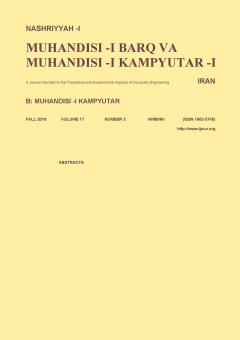کدگذاری مبتنی بر علامت- رقم برای نگاشت دادههای دیجیتال در حافظه ذخیرهسازی زیستی مبتنی بر DNA
الموضوعات : electrical and computer engineeringمیثم اللهی رودپشتی 1 , سعیده علینژاد 2
1 - مهندسی برق و کامپیوتر
2 - دانشگاه صنعتي نوشیرانی بابل
الکلمات المفتاحية: DNAسامانه ذخیرهسازی زیستیکدگذاریالگوریتم نگاشتعلامت- رقمکلانداده,
ملخص المقالة :
امروزه به دلیل افزایش دادههای مهم موجود در جهان به ذخیرهسازهایی با تراکم ذخیرهسازی بیشتر نیاز است و از این جهت استفاده از حافظههای مولکولی زیستی در پژوهشهای اخیر مورد توجه قرار گرفته است. DNA به عنوان یک ذخیرهساز مولکولی میتواند حجم زیادی از داده را در فضای محدود و با ماندگاری بالا ذخیره کند. انتخاب یک نگاشت مناسب از داده دیجیتال به الفبای DNA اهمیت زیادی دارد. در این مقاله، یک روش جدید برای نگاشت داده دیجیتال به الفبای DNA با هدف سادگی کدگذاری و کدگشایی، حذف خطای کدگشایی، ذخیرهسازی دادههای دیجیتال و علامت- رقم با فشردگی مناسب و سرعت کدگذاری بالا برای دادههای کلان پیشنهاد شده است. بررسیهای انجامگرفته نشان میدهد که روش پیشنهادی در مقایسه با روشهایی پیشین میتواند بازیابی اطلاعات از DNA را در مدت طولانی تضمین نماید. همچنین به دلیل دستاوردهای حاصلشده نسبت به روشهای پیشین از فشردگی کمتری برای ذخیره دادههای دیجیتال بهره میگیرد.
[1] Data storage supply and demand worldwide, from 2009 to 2020, Available at: https://www.statista.com/statistics/751749/worldwide-data-storage-capacity-and-demand, 2018.
[2] Where in the world is storage? Available at: https://www.idc.com/downloads/where_is_storage_infographic_243338.pdf, 2013.
[3] Sony develops magnetic tape technology with the world’s highest recording, 2014. Available at: www.sony.net/SonyInf/News/Press/201708/17-070E/index.html.
[4] ExtremeTech. New optical laser can increase DVD storage up to one petabyte, Available at: https://www.extremetech.com/computing/ 159245-new-optical-laser-can-increase-dvd-storage-up-to-one-petabyte
[5] Sh. Pep, Storing Your Data on DNA? Sept. 2018, Available: https://www.capconnect.com.au/single-post/DNA-Storage.
[6] J. Bornholt, R. Lopez, L. Ceze, G. Seelig, and K. Strauss, "A DNA-based archival storage system," in Proc. of the 21st Int. Conf. on Architectural Support for Programming Languages and Operating Systems, ASPLOS’16, pp. 637-649, Atlanta, GA, USA, 2-6 Apr. 2016.
[7] A. Garg and M. Choudhary, "Analysing and obtaining the most efficient DNA computing algorithm," J. of Computational Intelligence in Bioinformatics, vol. 8, no. 1, pp. 1-6, Jun. 2015.
[8] D. Limbachiya and M. Kumar Gupta, "Natural data storage: a review on sending information from now to then via nature," ACM J. on Emerging Technologies in Computing Systems, vol. 18, no. 1, pp. 550-4832, May 2015.
[9] L. Organick, S. Dumas Ang, and Y. J. Chen, "Random access in large-scale DNA data storage," Nature Biotechnology, vol. 12, no. 1, pp. 242-248, Feb. 2018.
[10] E. Willerslev, A 700.000 year old horse gets its genome sequenced, https://news.ku.dk/all_news/2013/2013.6/a-700.000-year-old-horse-gets-its-genome-sequenced, 2013.
[11] B. Alberts, et al., Essential Cell Biology, Essential Cell Biology, Garland Science, 3rd Edition, 2009.
[12] Harvard cracks DNA storage, crams 700 terabytes of data into a single gram. https://www.extremetech.com/extreme/ 134672-harvard-cracks-dna-storage-crams-700-terabytes-of-data-into-a-single-gram.
[13] R. Heckel, "An archive written in DNA," Nature Biotechnology, vol. 36, no. 3, pp. 236-237, Mar. 2018.
[14] N. Goldman, P. Bertone, S. Chen, C. Dessimoz, E. M. LeProust, B. Sipos, and E. Birney, "Towards practical, high-capacity, low-maintenance information storage in synthesized DNA," Nature Biotechnology, vol. 494, no. 7435, pp. 77-80, Jan. 2013.
[15] D. Huffman, "A method for the construction of minimum-redundancy codes," in Proc. of the IRE, vol. 40, no. 9, pp. 1098-1101, Sept. 1952.
[16] G. M. Church, Y. Gao, and S. Kosuri, "Next-generation digital information storage in DNA," Science 337, 1628 2012.
[17] R. Grass, R. Heckel, M. Puddu, D. Paunescu, and W. Stark, "Robust chemical preservation of digital information on DNA in silica with error-correcting codes," Angewandte Chemie International Edition, vol. 54, no. 8, pp. 2552-2555, Feb. 2015.
[18] M. Blawat, et al., "Forward error correction for DNA data storage," Procedia Computer Science, vol. 80, Issue: C, pp. 1011-1022, Jun. 2016.
[19] Y. Erlich and D. Zielinski, "DNA fountain enables a robust and efficient storage architecture," Science, vol. 355, no. 6328, pp. 950-954, Mar. 2017.
[20] S. Yazdi, R. Gabrys, and O. Milenkovic, "Portable and error-free DNA-based data storage," Scientific Reports, vol. 7, no. 1, Article No. 5011, Jul. 2017.
[21] A. Chandrasekaran, O. Levchenko, D. Patel, M. MacIsaac, and K. Halvorsen, "Addressable configurations of DNA nanostructures for rewritable memory," Nucleic Acids Research, vol. 45, no. 19, pp. 11459-11465, Jul. 2017.
[22] B. Wang, Y. Xie, S. Zhou, X. Zheng, and C. Zhou, "Correcting errors in image encryption based on DNA coding," Molecules, vol. 23, no. 8, p. 1878, Aug. 2018.
[23] H. Lee, R. Kalhor, N. Goela, J. Bolot, and G. Church, "Terminator-free template-independent enzymatic DNA synthesis for digital information storage," Nature Communications, vol. 10, no. 1, p. 2283, Jun. 2019.
[24] I. Koren, Computer Arithmetic Algorithms, 2nd Edition, Published by A. K. Peters, Natick, MA, 2002.
[25] DNA Replication and Causes of Mutation, Available at: .https://www.nature.com/scitable/topicpage/dna-replicationand-causes-of-mutation-409.


